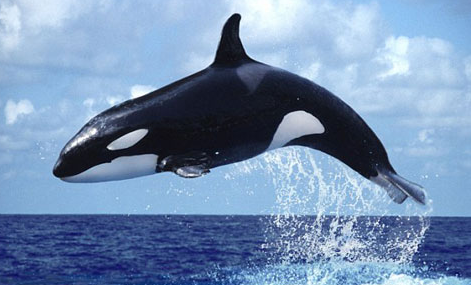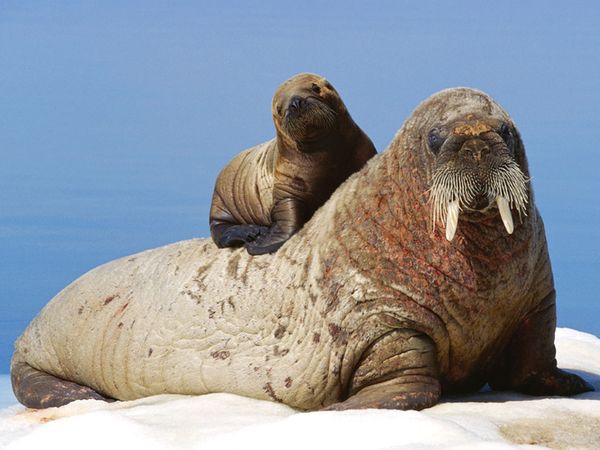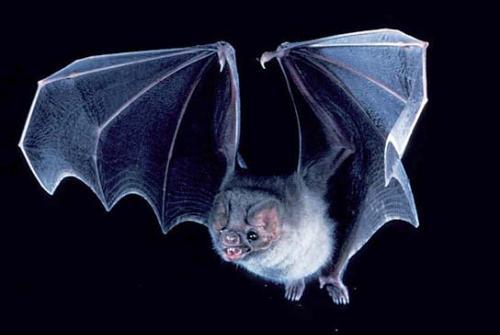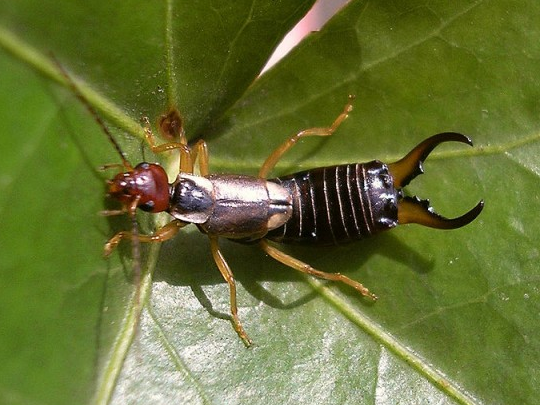5.Strawberry Poison Dart Frog
5.草莓箭毒蛙
The Scare Factor: At first glance, these amphibians don't seem dangerous; in fact, you can even call them "cute." But if you try to sink your predator's teeth into a strawberry poison dart frog… Well, let's just say it might be the last thing you'll ever do. Also, even if you survive, you'll have to deal with paralysis, tissue death and other unpleasant side effects of toxins present in this frog's skin.
恐怖指数:一眼望去,这些两栖动物似乎无害;事实上,你甚至觉得它们很漂亮。但是如果你胆敢去招惹它的话,那好吧,那将会是你在世界上做的最后一件事情。当然,假使你侥幸存活,你也要处理麻醉、组织死亡的问题,以及来自箭毒蛙皮肤毒素的负面影响。

The Care Factor: Granted, females of this species aren't very productive, since they can only lay up to five eggs at a time. However, they make up for it with parental habits unusual for frogs: The mother deposits each egg at a separate location, comes back to them every few days, and feeds them unfertilized food eggs. (To be fair, this is done to prevent the tadpoles from cannibalizing each other, but you still have to give Mom points for going through all that trouble.) Once the tadpoles hatch, they're left on their own to grow and terrorize predators with their brightly-colored skins of death.
爱心指数:当然,这类雌性毒箭蛙并不多产,一次仅能产五个卵子。然而,它们会弥补自身与其他平常的蛙类的不同:雌性毒箭蛙会将每一个卵子分别放置,过一段时间再来看它们,给它们喂食未受精的卵子。(公平地说,这样做是为了蝌蚪互相蚕食。但你仍要给雌蛙一点分数,以称赞它们以此度过那样的困境。)一旦蝌蚪开始孵化,雌蛙就会离开,让幼蛙独立成长,并用自己色泽光亮、蕴含毒素的皮肤吓退捕食者。
4.杀人鲸

The Scare Factor: "Killer" sounds about right for this powerful marine animal. As predators of whales, seals, and even great white sharks, killer whales managed to propel themselves to the top of the ocean food chain, and stay there. The fact that their intelligence rivals ours is worrisome too; what if they eventually figure out how to use their flippers to walk on land? (For now, let's be thankful evolution works really, really slowly.)
恐怖指数:对最凶猛的海洋动物来说,"杀手"是它最合适的称谓。作为白鲸、海豹、甚至是大白鲨的天敌,杀人鲸努力地挤上海洋食物链的顶端,并稳居不下。它们的智力可与人类相竞争,这是一个堪忧的事实。最终如果它们想出如何用脚蹼在陆地上行走,将会怎样呢?(那么暂时,让我们感谢进化之缓慢吧!)
The Care Factor: Then again, Mother Nature probably wanted to downplay the orcas' fearsome reputation, seeing as she made "Momma's Boys/Girls" out of killer whale calves. In particular, studies have found that male orcas stay with their mothers well into their 30s to boost their chances of survival. The same goes for female orcas, though to a much lesser extent. Makes you wonder whether orca moms grumble about their adult children, too.
爱心指数:其次,大自然可能想淡化虎鲸这种吓人的名声,因此让幼虎鲸成为妈妈疼爱的小宝贝儿。特别是,雄虎鲸会在它们的妈妈身边停留30年,以提高它们的生存机率。雌虎鲸也同样会这样,即使只有很小一部分会这样。这让你想知道这些虎鲸妈妈是否也会对她们的成年孩子发牢骚。
3.海象

The Scare Factor: Seriously, would you want to be anywhere near a walrus? Even if it can't skewer you with its distinct tusks (which, by the way, have been known to kill polar bears), you can still get squished under its 4,400 lb frame if you're unlucky enough to be in the wrong place at the wrong time. (Like some of their own calves, for instance.)
恐怖指数:说真的,你会愿意靠近海象吗?即使它不能用独特的獠牙刺穿你(顺便说一下,它的獠牙是杀死北极熊的利器),但如果你很不幸地在错的时间和地点里出现,仍会被它4400磅的体重给压扁。(就像一些它们自己的孩子)
The Care Factor: Fortunately, walrus mothers know the extent of their Powers of Squish. They let their calves sit on their backs to protect them from predators, and from other lumbering walruses who don't know any better. Also, they nurse their children 'til the latter are two years old, while teaching them valuable life skills like hunting for food – and maybe being nice to the other walruses.
爱心指数:幸运的是,海象妈妈熟知自己能压扁的力量范畴。它们让它们的幼儿坐在自己的背上,保护它们免受捕食者的伤害,也保护它们不被那些一无是处的笨重海象压到。同时,它们把它们的孩子照料到两岁,教它们一些有价值的生存技巧,比如猎食和更友好地与其他海象相处。
2.吸血蝙蝠

The Scare Factor: If Dracula had a real-life incarnation other than Vlad Tepes, he'd be a vampire bat. As their name implies, vampire bats feed exclusively on blood – which includes that of humans. Even if they don't have the ability to turn victims into soulless, bloodthirsty creatures like themselves, vampire bats are infamous for spreading rabies wherever they live.
恐怖指数:如果德拉库拉除了费德拉·特彼斯之外还有一个真实化身的话,那就是吸血蝙蝠。正如它们的名字所暗示的那样,吸血蝙蝠专以血液为食,其中也包括人类的血液。尽管它们不能给受害者造成致命的伤害,像吸血蝙蝠这样的嗜血生物却因他们在其生存的地方传播狂犬病而臭名昭著。
The Care Factor: Because blood is surprisingly scarce as a food source, vampire bat mothers have to make up for it by regurgitating congealed blood for their hungry, helpless pups. This goes on for several months, until the pups become old enough to hunt on their own. If a pup loses his mother too early, he can expect to be well-cared for by his mother's roostmates, since vampire bats are known to adopt orphans. Who knew these unholy creatures are capable of something so noble?
爱心指数:因为血是极其稀有的一种食物种类,雌吸血蝙蝠必须吐出凝结的血液来喂养它们的幼儿,直到幼儿成长到可以自己猎食为止,这样的状况需持续几个月。如果一个幼儿过早的丧失了它的母亲,它有望由它母亲的室友所照料,因为吸血蝙蝠向来因收养孤儿而著称。谁会知道这些罪恶的生物从事着如此高贵的事呢?
1.土蚣

The Scare Factor: Earwigs get their name from their alleged habit of burrowing into people's ears. While "alleged" is in that previous sentence for a reason, there's no denying that these insects are unsettling to look at – what with their resemblance to cockroaches wielding "pincer derrieres" and all.
恐怖指数:土蚣这一名称源于传闻中它们钻入人耳的习性。虽说是传闻,但当人们看向那些与蟑螂有着相似的"钳子臀部"的昆虫时,无疑会感到不安。
The Care Factor: Generally, solitary insects aren't skilled in the parenting department. The earwig's an exception, though; the mother takes care of her 40 to 45 eggs by warming, protecting, and clearing them of fungi. She also feeds them her own saliva and regurgitated food, until they molt for a second time and are ready to take off on their own. In case she dies before her offspring are fully grown, she still "takes care" of them by letting them feed on her corpse. Now that's a hardcore mother!
爱心指数:通常来说,独居的昆虫不会在抚育儿女这一环节中死亡,而土蚣却是个例外。土蚣妈妈通常用孵化、保护、清理卵上的真菌的方式来照料四十至五十个卵,它也用自己的唾液及嚼碎的食物来喂养幼儿,直到它们第二次蜕皮或可以自己蜕皮为止。假使在她的后代完全长大之前土蚣妈妈死了,它仍然会通过它的尸体来喂养幼儿,这是真正的铁杆母亲!

















